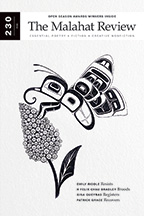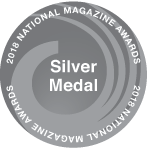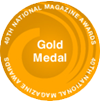Writing as Invitation: Janine Alyson Young interviews Catherine St. Denis
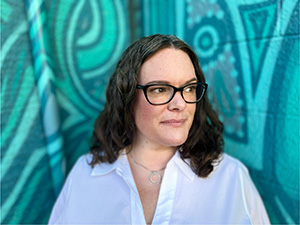
Past contributor Janine Alyson Young talks with Catherine St. Denis, winner of 2025's Open Season Fiction Award with her story, “Bubble Bath and the Ecstasy of Diminishing,” featured in our spring issue #230. They discuss the tension between body and food in the story, thinking of the reader as you write, and how a first draft is like intuiting the contours of a map.
Read and excerpt of "Bubble Bath and the Ecstasy of Diminishing" here.
Catherine St. Denis (she/her) lives, writes, sings, teaches, and parents on the unceded territories of the Lekwungen peoples in Victoria, BC. Her work previously appeared in Rattle, The Malahat Review (issue 221), Grain, Arc, Canthius, and The Humber Literary Review. Once shortlisted and twice longlisted for the CBC Poetry Prize, she has also been shortlisted for the Far Horizons Award for Poetry, The Fiddlehead's Poetry Prize, The Toronto Arts and Letters Club Award, and The Foster Poetry Prize. Catherine was a finalist for PEN Canada's New Voices Award in both 2022 and 2023. Her work is featured in Biblioasis’ Best Canadian Poetry 2025.
Read what OSF judge Corinna Chong had to say about her winning story.
Congratulations on winning the 2025 Open Season Fiction Award! Judge Corinna Chong called this piece “a confidently written and gut-punchingly honest story about the complicated and even toxic relationships young women harbour with each other and with their own bodies in contemporary society.” What caught my attention in particular was the imbalance of intimacy between our main character, Lilith, and her best friend, Mabel. Lilith is bound to two inescapable powers—body image and self-harm—and both stem from a moment in childhood with Mabel. Later we learn that Lilith has never told Mabel about cutting (“she always changes into her pajamas in the bathroom when they have a sleepover” is such a telling line); meanwhile, Lilith is literally helping Mabel do arts and crafts with her vagina. Can you speak to how Lilith is shaped by her relationship with Mabel and how the layers of intimacy, or lack of, between Lilith and Mabel affect her?
Thank you for the congratulations, Janine! I love how you point out the imbalance in intimacy between Lilith and Mabel. It’s certainly true that Lilith hides much of herself, physically and emotionally, from Mabel, while Mabel is completely uninhibited with Lilith, and this does indicate a huge imbalance in the relationship. However, as I see it, both of them are products of the toxic environment in which they have been swimming all their lives, infused with the narratives that girls’ and women’s bodies are both marketable products and personal liabilities. So, while Mabel holds power over Lilith by zeroing in on her fatness, Lilith holds power over Mabel by keeping her inner world and self-harm hidden from someone who is supposed to be her best friend. The tragedy of their relationship is that as they both jostle against one another, what they really crave is authentic connection. The fact that they do not achieve this drives each of them to further extremes: Mabel, outward and antagonistically, and Lilith, inward and self-punitively.
There’s such a visceral tension between the body and food in this story. I appreciated that we didn’t see a teenage girl struggling with diet as one might expect, but rather there is the squeamish negotiation between what makes food insanitary in relation to the body. There is the Subway boss who fires Lilith because her cutting marks are “not sanitary”; the piss in the pickles; the molar in the Coke; and “a hamburger-sized patch of blood” on Lilith’s sleeve. It’s like a twist on the wellness culture’s icky concept of “clean” versus “unclean” food, and it’s so surprising and effective. How did these details develop in your writing and why?
What is wonderful about your question is that I hadn’t realized I had done that. But, yes, of course—there it is! My first thought is that I may have done this because it is unsettling to be presented with the contrasts between food and the less sanitary aspects of the body. We like to think of bodies as contained and operating within clean boundaries, but really they are so messy and unmanageable, and we are so often taught to keep these messy and unmanageable aspects to ourselves. And characters are messy, too, particularly ones who are as stigmatized as self-harming teenage girls and unhoused addicts. While I didn’t consciously include the clean/unclean food motif, I do like the idea of putting stigmatized bodies adjacent to or in food that readers can imagine themselves eating. It is an opportunity for readers to reckon with their own disgust.
The first line of your story sparks curiosity by combining three seemingly incongruous details—a job at McDonald’s, cutting, and a childhood memory. It’s a sharp and luring opening, followed by a flashback that almost loses the present moment but ultimately succeeds, which shows great craft. Can you talk about your process of stepping into a short story? How do you move from inspiration to writing to really understanding what the story is about?
I’ll admit that I have not yet written much fiction, and so I haven’t yet developed any habits in terms of my process in writing short stories. This particular story was seeded by an encounter I had with a young woman at a McDonald’s drive-through. Her service was exemplary, and her arms were completely covered in self-harm scars. I felt so sad for her as I drove off. I wondered who, if anyone, she had in her corner.
When writing this story, I began with the first sentence, and it pretty much wrote itself from there. I find that, across all genres, the process of writing my initial draft is a bit like intuiting the contours of a map; I’ll find myself having written something and think, “Oh, this is where it’s going. This is the layer. This is the path.” And then I will carve into those moments and follow them wherever they lead, which is most often to the truth of the matter. The editing process is about enhancing the contours, but by the end of the initial draft, I’ve usually determined what I think the piece is about.
I read in your author bio that you’re also a poet. How does your writing process differ between genres? How do different genres play off each other in your writing? What are you working on right now?
Something that I love about working in multiple genres is how the strengths and possibilities of each genre can inform the others. In a poem, it is possible to isolate a symbol, idea, image, or emotion without necessarily including narrative or narrative tension, and I think this can provide a writer with a sense of the infinite building blocks and architectural possibilities when it comes to story writing or creative nonfiction writing. Further, poets habitually take a microscope to language on a word-by-word level, and they naturally evoke the musicality of language. These habits are transferable to other genres and, in my opinion, serve to strengthen the work. On the flip side, elements traditionally associated with fiction like narrative arcs, characterization, point of view, narrative distance, and world-building can all serve to enhance poetry and CNF. When I first started writing fiction, I felt uncertain about whether I would be successful in the genre, but as I wrote, I realized how often I had already been using the tools of narrative in my poetry.
I have recently completed my first collection of poetry and it’s currently out to a number of presses. My main project right now is working towards compiling a collection of short stories, and the themes that seem to be emerging surround fatness, queerness, disability, parenthood, and technology.
When you write, do you think of your audience? I find most writers emphatically say “No!” to this question and it always surprises me—I do! If no, what turns you on to write? If yes, at what point in the process do you invite your readers in?
I am almost always thinking about the reader as I write. For me, writing is a conversation—between myself and my readers, and between myself and other writers. I think the power of storytelling comes from the way it links people, so why wouldn’t I think about those linkages as I write? To me, all writing is an invitation—into another world, another perspective, another emotional climate. The invitation happens right from the beginning of the piece, and so I think about it right away.
One thing I’d like to differentiate here, though, is that thinking about the audience/reader while writing is wholly different than thinking about the marketability of a piece, which I believe can be counterproductive. I was recently reading an article by novelist Garth Greenwell wherein he discusses the fact that “the commodification of art is the devil” and he describes the way that “That intimate communication between writer and reader, that miracle of affective translation across distance and time, is the real life of literature.”
I am still an emerging writer, but it has been the highlight of my writing life to have readers I have never met before reach out to tell me how much a piece impacted them, how it changed them irrevocably. What could be more powerful than that?
Thank you so much for these thoughtful questions, Janine. It has been a pleasure.
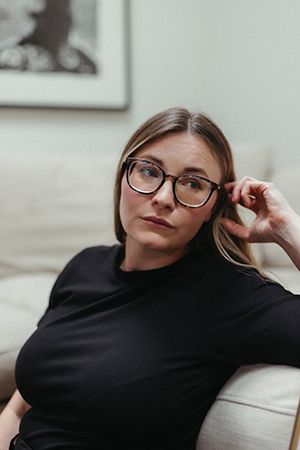
Janine Alyson Young

